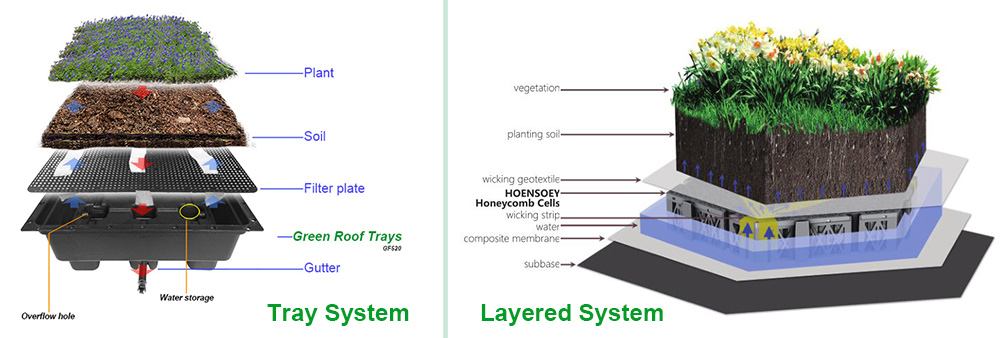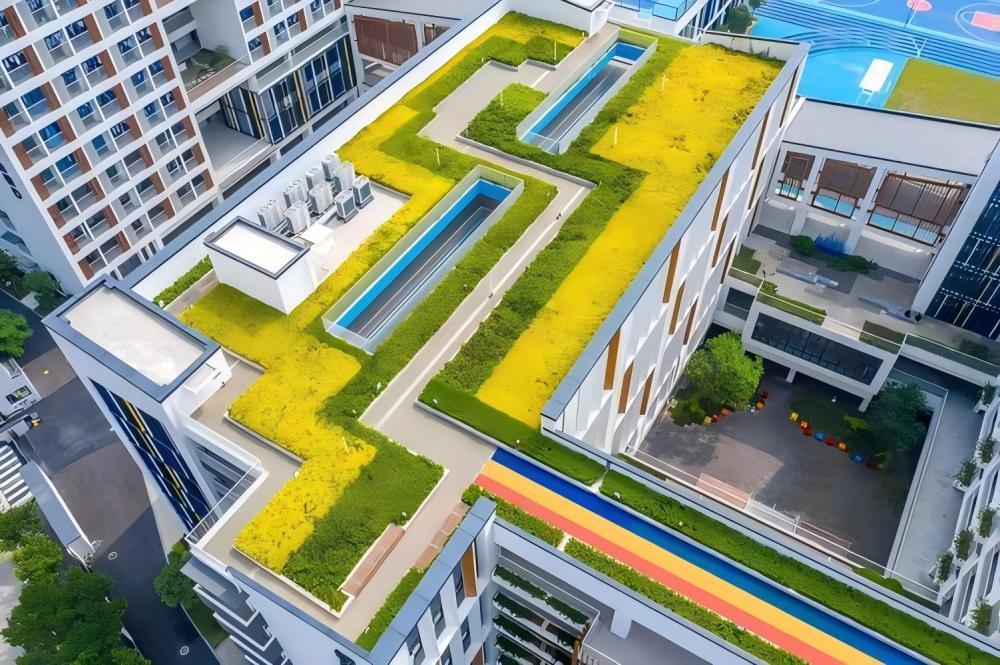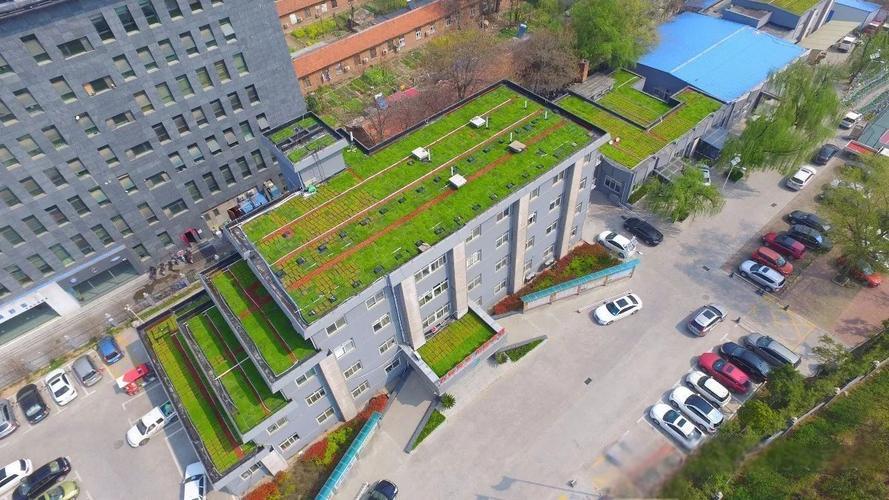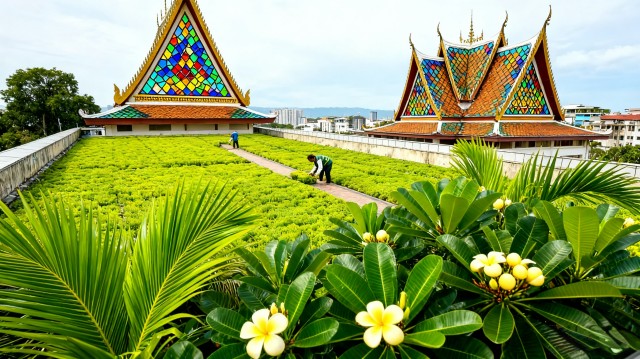Promoting Sustainability with Green Roof Systems: Eco-Friendly Layered and Tray Solutions
2024-08-31
As we face growing environmental
challenges, green roof systems have emerged as a powerful tool for promoting
sustainability in urban areas. These systems offer multiple benefits, from
reducing urban heat islands and improving air quality to enhancing biodiversity
and managing stormwater. This article explores the environmental and
sustainable advantages of the two primary green roof systems: the Layered
Green Roof System and the Tray Green Roof System. Special attention
is given to the role of Hoensoey Cells in advancing sustainability
within the Layered System and the eco-friendly innovation of HT-508 Modular
Green Roof Trays in the Tray System.

Layered Green Roof System: A Sustainable
Approach
The Layered Green Roof System is an
environmentally conscious design that allows for the precise placement of
various layers, each contributing to the overall sustainability of the roof.
This system typically includes layers for waterproofing, drainage, filtration,
soil, and vegetation, all of which work together to create a thriving green
space.
At the heart of this system's
sustainability is the use of Hoensoey Cells. These cells are not just a
structural component but a vital part of the roof's water management strategy.
Through a capillary action mechanism, Hoensoey Cells provide passive
irrigation, ensuring that plants receive the necessary moisture without the
need for excessive water use. This reduces the overall water footprint of the
building and helps conserve this precious resource. Moreover, by enhancing
water retention and reducing runoff, Hoensoey Cells play a crucial role in
mitigating the impact of heavy rainfall, making urban environments more
resilient to climate change.
Environmental Benefits:
- Water Conservation: Hoensoey Cells
reduce the need for external watering, conserving water and lowering
utility costs.
- Stormwater Management: By retaining
and slowly releasing water, these cells help reduce the strain on urban
drainage systems.
- Biodiversity Support: The Layered
System can support a diverse range of plants, creating habitats for
various species and promoting urban biodiversity.
Keywords:
Sustainable Green Roof System, Layered Green Roof System, Hoensoey Cells, Water
Conservation, Stormwater Management, Urban Biodiversity.

Tray Green Roof System: Eco-Friendly
Modularity
The Tray Green Roof System represents a modular approach to urban greening, offering flexibility and ease
of installation while contributing to environmental sustainability. This system
involves pre-assembled trays that combine all necessary layers—drainage,
filtration, and growing media—into a single, easy-to-install unit.
The HT-508 Modular Green Roof Tray by Hoensoey/Leiyuan exemplifies how green roof systems can be both eco-friendly
and user-friendly. These trays are designed for quick installation, which not
only saves time and labor but also minimizes the environmental impact of
construction. The HT-508 trays are made from sustainable materials, ensuring
that the trays themselves are part of the green solution. Additionally, these
trays can support a variety of plant species, helping to create green roofs
that are not only functional but also rich in biodiversity.
Environmental Benefits:
- Eco-Friendly Materials: HT-508
trays are crafted from sustainable resources, reducing the environmental
impact of their production and disposal.
- Reduced Construction Impact: The
modular nature of the trays allows for minimal disruption during
installation, making them ideal for projects with tight environmental
constraints.
- Flexible Urban Greening: The trays
can be easily rearranged or replaced, allowing for adaptive green spaces
that evolve with the environment.
Keywords:
Green Roof System, Tray Green Roof System, HT-508, Modular Green Roof Trays,
Sustainable Materials, Biodiversity Enhancement, Eco-Friendly Design.

Sustainability Comparison: Layered vs.
Tray Green Roof Systems
Both the Layered Green Roof System and the Tray Green Roof System offer significant environmental benefits,
but their applications may differ based on specific sustainability goals. The
Layered System, with the integration of Hoensoey Cells, excels in projects
where long-term water conservation and stormwater management are priorities.
Meanwhile, the Tray System, particularly with the HT-508 trays, is ideal for
projects where flexibility, rapid deployment, and the use of eco-friendly
materials are critical.
Keywords:
Sustainable Green Roof Comparison, Layered vs. Tray Green Roof, Environmental
Impact, Urban Sustainability, Climate Resilience.
In the quest for sustainable urban
development, choosing the right green roof system is essential. The
Layered Green Roof System, enhanced by Hoensoey Cells, offers unmatched water
management and ecological benefits, making it a cornerstone of environmentally
responsible architecture. On the other hand, the Tray Green Roof System, featuring
HT-508 trays, provides a flexible and eco-friendly solution that can adapt to
the changing needs of urban spaces. By adopting these green roof systems,
cities can take significant steps toward a greener, more sustainable future.
Keywords:
Green Roof System, Hoensoey Cells, HT-508 Trays, Sustainable Urban Development,
Eco-Friendly Architecture, Green Building Solutions.
Call to Action for Sustainability
As urban planners, architects, and
community leaders, it’s time to embrace green roof systems as a vital component
of sustainable cityscapes. Whether through the advanced water management of
Hoensoey Cells or the modular innovation of HT-508 trays, these systems are
paving the way for greener, more resilient cities. Let’s make the commitment to
sustainable development today, for a better tomorrow.
Keywords:
Sustainable Green Roof Systems, Urban Resilience, Environmental Stewardship,
Green Cities, Climate Action.
PreviousHT-508 Green Roof Module: The Smart Choice for Cost-Effective Green Roofing
NextSponge Cities: Different Names, Applications, Development History, and Future Prospects
Message






